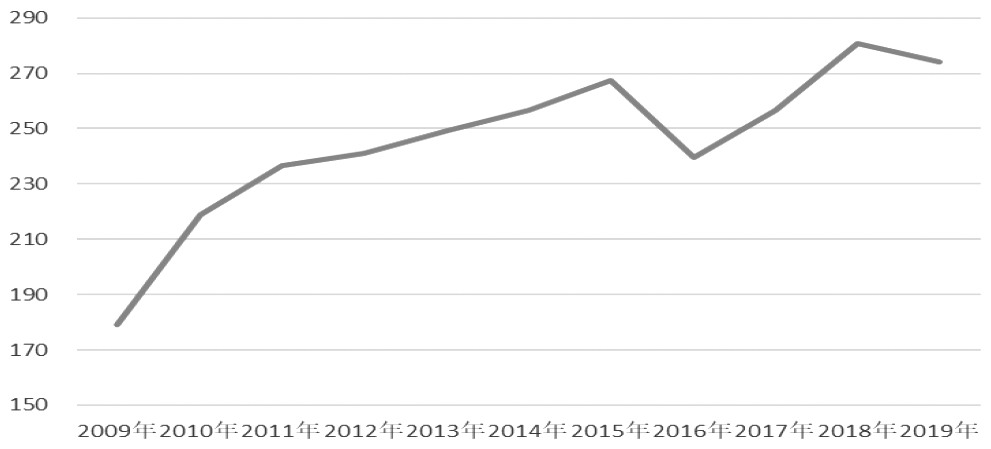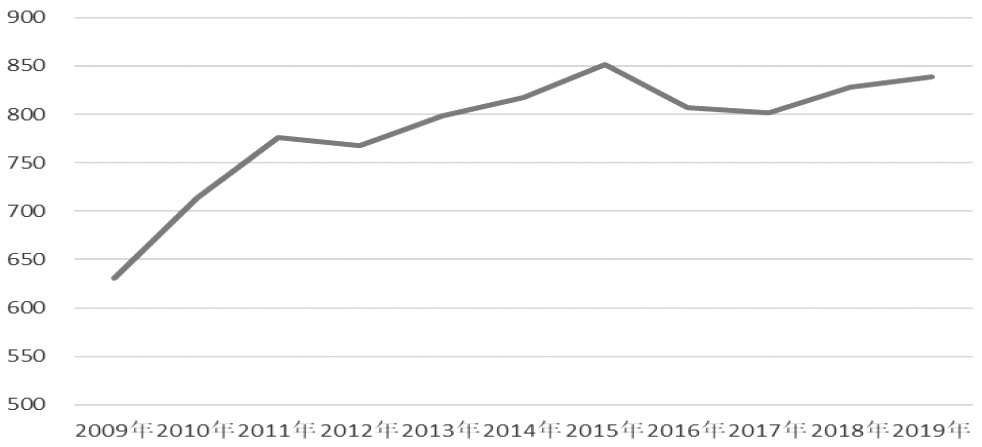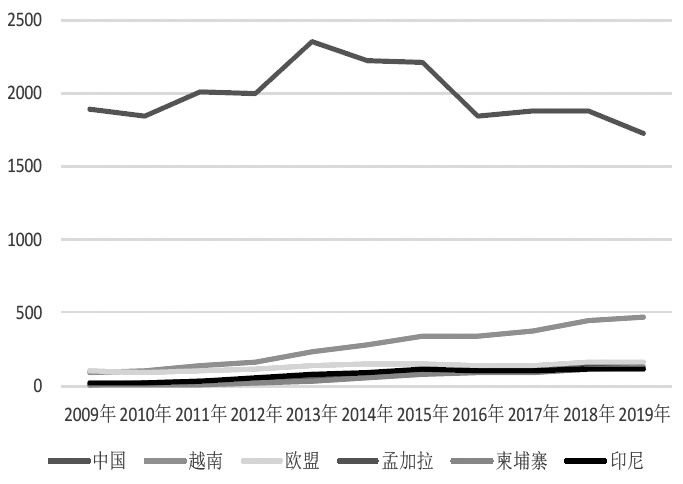In recent years, the flow of global textile and apparel trade has quietly changed. As the largest textile exporter and apparel exporter, China occupies an important link in the industrial chain. Due to changes in international relations and the rise of the textile and apparel industry chain in Vietnam, Bangladesh, India and other countries, international textile and apparel trade has shifted. China’s textile and apparel export share has been squeezed out in some regions and has begun to decline. This article selects China, the European Union, the United States, and Japan as the research targets, and analyzes the changes in China’s textile and clothing exports and the changes in imports from the European Union, the United States, and Japan in the past 10 years. The European Union, the United States, and Japan are China’s largest exporters of textiles and clothing, and they are also important links in the global textile and clothing trade. Selecting them as research objects can more intuitively display the changing trends of the global textile and clothing industry chain.
China’s textile and clothing exports
Textile exports: EU, United States , Vietnam accounts for the main share, and Vietnam’s share has increased significantly in 10 years
In 2019, China’s main textile export destinations are the European Union, the United States, Vietnam, Bangladesh, Japan, and China Hong Kong and Indonesia, among which China’s textile exports to the EU, the United States, and Vietnam all account for more than 10%, 22%, 10.4%, and 10.2% respectively. Bangladesh accounts for 5.4%, Japan accounts for 3.8%, and Hong Kong, China Accounting for 3.6%, Indonesia accounted for 3.5%. China’s textile exports to the United States fell by 9% year-on-year in 2019, exports to Bangladesh also fell by 4.6% year-on-year, and Vietnam increased by 4% year-on-year.
By comparing the data between 2009 and 2019, it can be found that the proportion of China’s textile exports to the EU and the United States has not changed much in 10 years, while the proportion of China’s textile exports to Hong Kong, China The proportion of textile exports in China has declined significantly, by 8%. The proportion of exports to Vietnam has increased by 6.5% in 10 years, from 3.7% in 2009 to 10.2% in 2019.

The table shows the distribution of China’s main textile exports in 2009 and 2019 (unit: 10,000 US dollars)
Clothing exports : The share of clothing exports to the EU and Japan has declined significantly in the past 10 years
In 2019, China’s main clothing export destinations were the EU, the United States, and Japan, with the proportions of these three being 11.4% respectively. %, 21.6%, 10%. In 2019, the value of China’s clothing exports fell by 4% year-on-year. The value of China’s clothing exports to the EU, the United States, and Japan all declined year-on-year, with the United States experiencing the largest decline.
By comparing the data between 2009 and 2019, it can be found that the value of China’s clothing exports increased by 41.6% compared with 10 years ago. In addition to the United States, China’s exports to the European Union, The value of Japan’s clothing exports has declined, and its proportion has also declined significantly.

The table shows the distribution of China’s main apparel exports in 2009 and 2019 (unit: 10,000 US dollars)
U.S. textiles and clothing imports
U.S. textiles and clothing imports totaled US$221.2 billion in 2019, of which clothing imports amounted to US$83.8 billion and textile imports amounted to US$27.4 billion. US dollars, the ratio between the two is 3:1.
Textile imports: China has the largest share, but its share has not changed much in the past 10 years, and India’s share has slowly increased

The picture shows American Textiles Changes in import value over the past ten years (unit: 100 million U.S. dollars)
According to historical data statistics from the U.S. Office of Textiles and Apparel (OXTEA), from 2009 to 2019 In the past 10 years, the US textile imports have shown an overall growth trend. Except for the year-on-year decrease in textile imports in 2016 and 2019, the other years have increased year by year. In 2019, U.S. textile imports increased by 53% compared with 2009.
Looking at the textile import market, the main import source country is China, accounting for 42% in 2019, followed by India accounting for 14.6%, and the EU accounting for 8.5%. third. Among them, China has been the largest source of textile imports for the United States since 2009. In the past 10 years, the amount of textiles imported by the United States from China has been basically consistent with the amount of textiles imported from the world. The proportion of textiles imported from China has basically remained at 40-40. 50%. In 2019, the proportion fell by 4.9% year-on-year. The reason is related to the Sino-US trade friction. India, the second source of U.S. textile imports, accounted for only 9.2% 10 years ago, lower than the EU. However, in the past 10 years, the amount of U.S. textile imports from India has increased year by year, and the proportion has also been increasing; although the EU accounted for ratio is 14%, second only to China, but the proportion will fall by 6% year-on-year in 2022, and will basically maintain 7.5-8.5% thereafter.
Clothing imports: Vietnam suddenly emerges to squeeze out China’s export share
The amount of U.S. clothing imports has also increased in 10 years The overall trend is growing. In 2019, U.S. apparel imports amounted to US$83.8 billion, an increase of 32.8% from US$63.1 billion in 2009.

<p stJapan's textile imports amounted to US$907 million, a year-on-year increase of 55% from 2009.
From the perspective of the textile import market, China is Japan’s largest source of textile imports, accounting for 54%. The proportion of textiles Japan imports from other countries is similar to that of China. The difference is very large, both below 10%. The amount of Japan’s textile imports from China has also shown a growth trend in the past 10 years. In 2019, it increased by 31% year-on-year compared with the value in 2009. Although China’s textile exports to Japan are large, by observing the changes in the import proportion over the past 10 years, we can also I can see something different. Japan’s share of China’s textile imports has shown a clear downward trend in the past 10 years, with a drop of nearly 10%. Vietnam’s share increased from 2.7% in 2009 to 9.3% in 2019.
Clothing imports: China’s share fell by 27 percentage points in ten years, Vietnam increased by 22 percentage points
Similar to the distribution of textile imports, Japan’s main source of clothing imports is also China, accounting for 56.8%. In the past 10 years, Japan’s clothing imports from China have shown an overall trend of first increasing and then rising. The value in 2019 fell 8% year-on-year compared with 10 years ago. . Judging from the proportion trend, Japan’s clothing imports from China have shown a very smooth downward trend, with the proportion in 2019 reduced by 27 percentage points compared with 2009; Vietnam, as the second source of Japan’s clothing imports, Japan’s clothing imports from It increased by 401% in 10 years, and the proportion increased steadily, reaching 22% in ten years.

The picture shows the trend of Japan’s clothing imports in the past 10 years (unit: million US dollars)

The picture shows the distribution of Japan’s clothing imports in the past 10 years ( Unit: %)
Summary
Pass research It was found that the flow of global textile and apparel trade has undergone significant changes in the past 10 years. As a traditional major exporter of textile and apparel, China’s export share has begun to decline, while the share of textile and apparel exports from emerging countries such as Vietnam and Bangladesh has increased significantly.
In terms of clothing, China’s main export destinations are the EU, the United States, and Japan. In 2019, the amount and proportion of China’s clothing exports to the EU and Japan dropped significantly compared with 10 years ago. , the amount and proportion of apparel exports to the United States increased compared with 10 years ago. In terms of countries, the United States’s proportion of China’s clothing imports fell by 6.9 percentage points in 10 years. At the same time, its proportion of Vietnam’s clothing imports increased by 8.3 percentage points. As for the EU, its proportion of China’s clothing imports increased by 10. It fell by 14 percentage points during the year. At the same time, its proportion of clothing imports from Bangladesh increased by 22%. As for Japan, its proportion of clothing imports from China fell by 27 percentage points in 10 years. At the same time, its proportion of clothing imports from Vietnam increased by 27 percentage points. an increase of 22 percentage points. It can be seen that the clothing production and export industries of Vietnam, Bangladesh and other countries have gradually grown in the past 10 years, competing with China, a traditional clothing export country, squeezing the export market, and the clothing industry chain is shifting.
In terms of textiles, China’s main export destinations are the European Union, the United States, and Vietnam. The share of Europe and the United States is basically the same as 10 years ago, but Vietnam’s share has increased significantly compared with 10 years ago. Broken down by country, China accounts for the largest share of U.S. textile imports at 42%. The import amount has increased overall in the past 10 years, but the proportion has not changed much. The second source of imports, India, has slowly increased its share. It is not ruled out that China’s share will be lost to other countries in the future. The emerging competition for textile export destinations; China also accounts for the largest share of textile imports in the EU at 38%. The import amount and proportion have shown an upward trend in the past 10 years. The EU currently does not see other countries squeezing China’s textile exports to it. Share; Vietnam’s textile imports from China have increased significantly in the past 10 years. This is because Vietnam’s clothing production and export industry has gradually expanded in recent years, but its textile industry chain is not complete enough and still needs to be met by imports. </p








